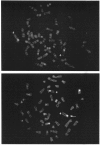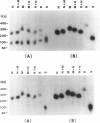Abstract
Wolf-Hirschhorn syndrome (WHS), associated with a deletion of chromosome 4p, is characterized by mental and growth retardation and typical facial dysmorphism. A girl with clinical features of WHS was found to carry a subtle deletion of chromosome 4p. Initially suggested by high-resolution chromosome analysis, her deletion was confirmed by fluorescence in situ hybridization (FISH) with cosmid probes, E13 and Y2, of D4S113. To delineate this 4p deletion, we performed a series of FISH and pulsed-field gel electrophoresis analyses by using probes from 4p16.3. A deletion of approximately 2.5 Mb with the breakpoint at approximately 80 kb distal to D4S43 was defined in this patient and appears to be the smallest WHS deletion so far identified. To further refine the WHS critical region, we have studied three unrelated patients with presumptive 4p deletions, two resulting from unbalanced segregations of parental chromosomal translocations and one resulting from an apparently de novo unbalanced translocation. Larger deletions were identified in two patients with WHS. One patient who did not clinically present with WHS had a smaller deletion that thus eliminates the distal 100-300 kb from the telomere as being part of the WHS region. This study has localized the WHS region to approximately 2 Mb between D4S43 and D4S142.
Full text
PDF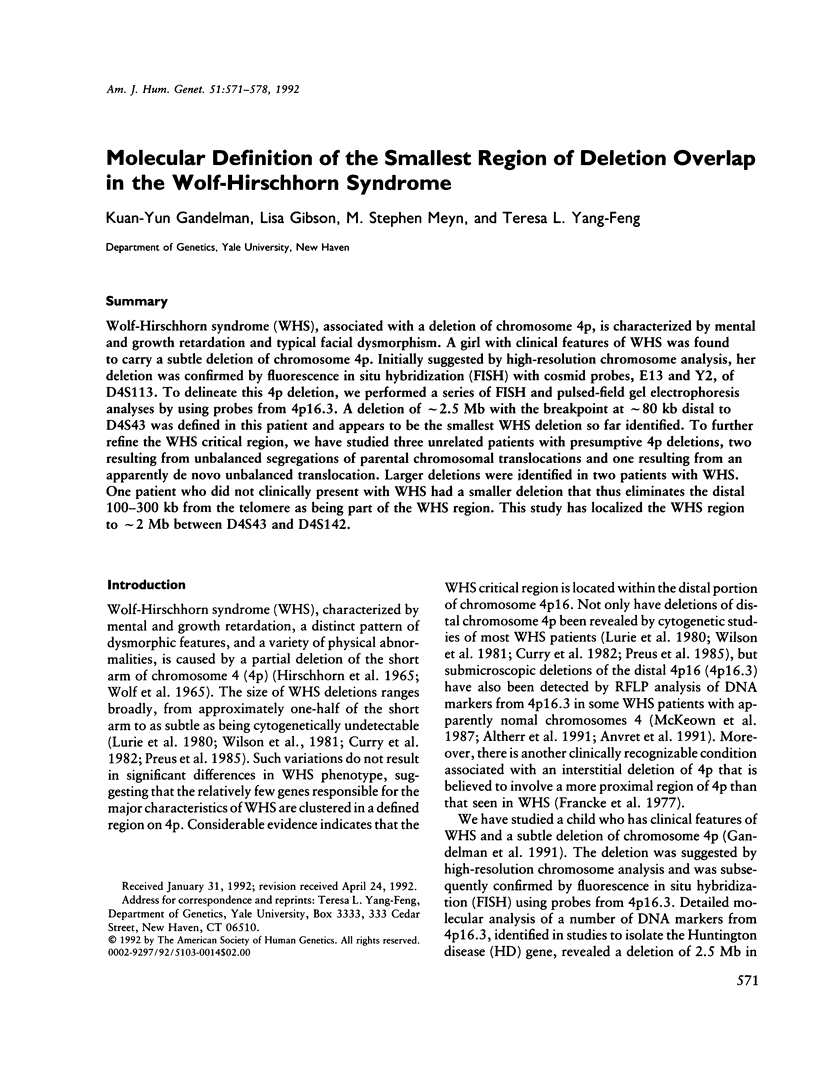
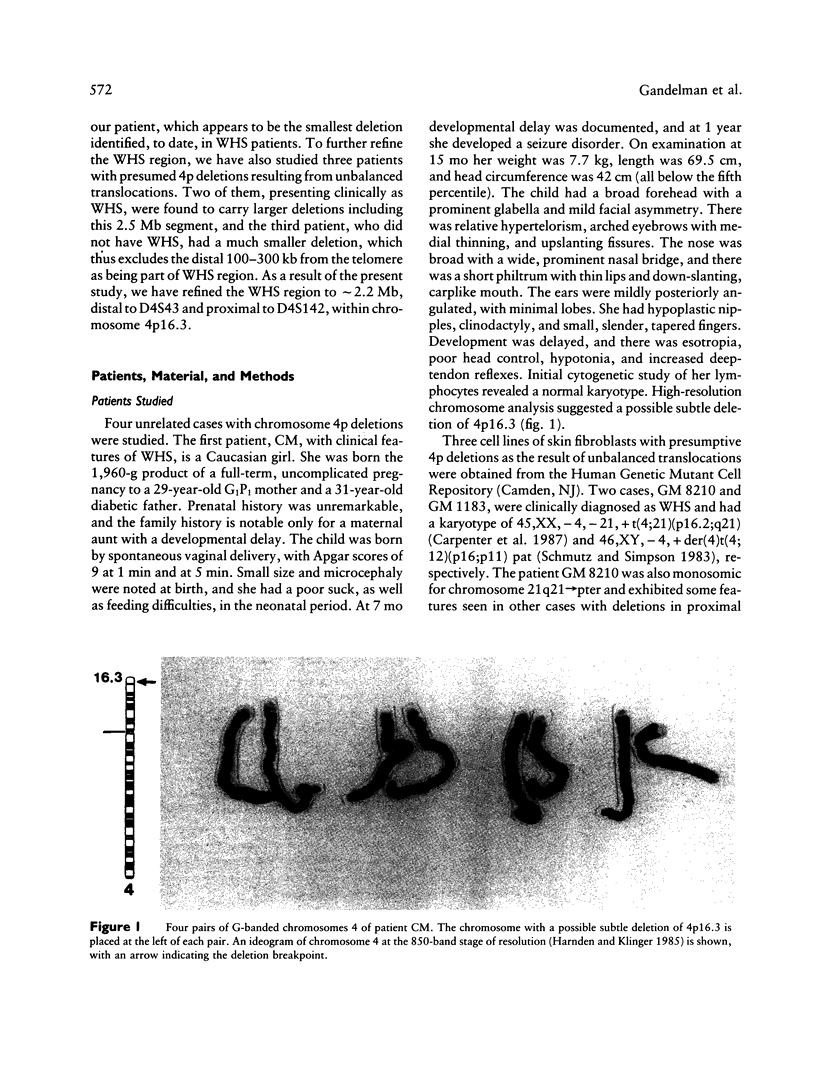
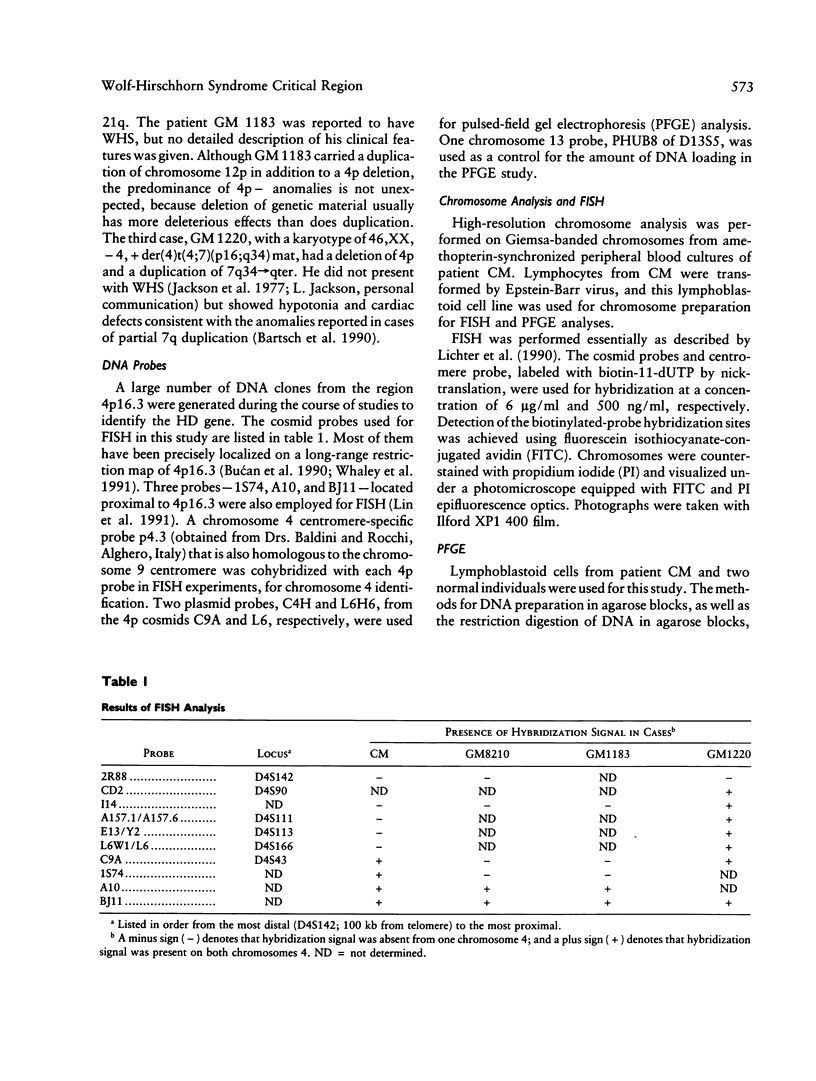
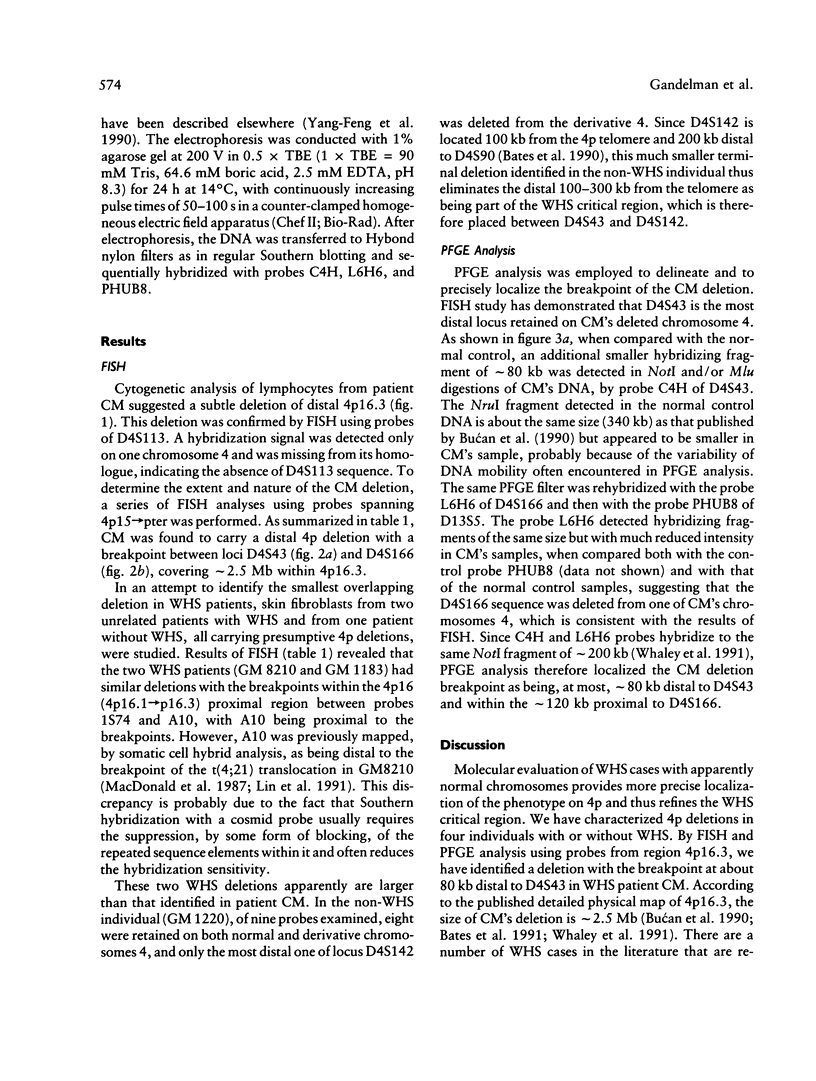
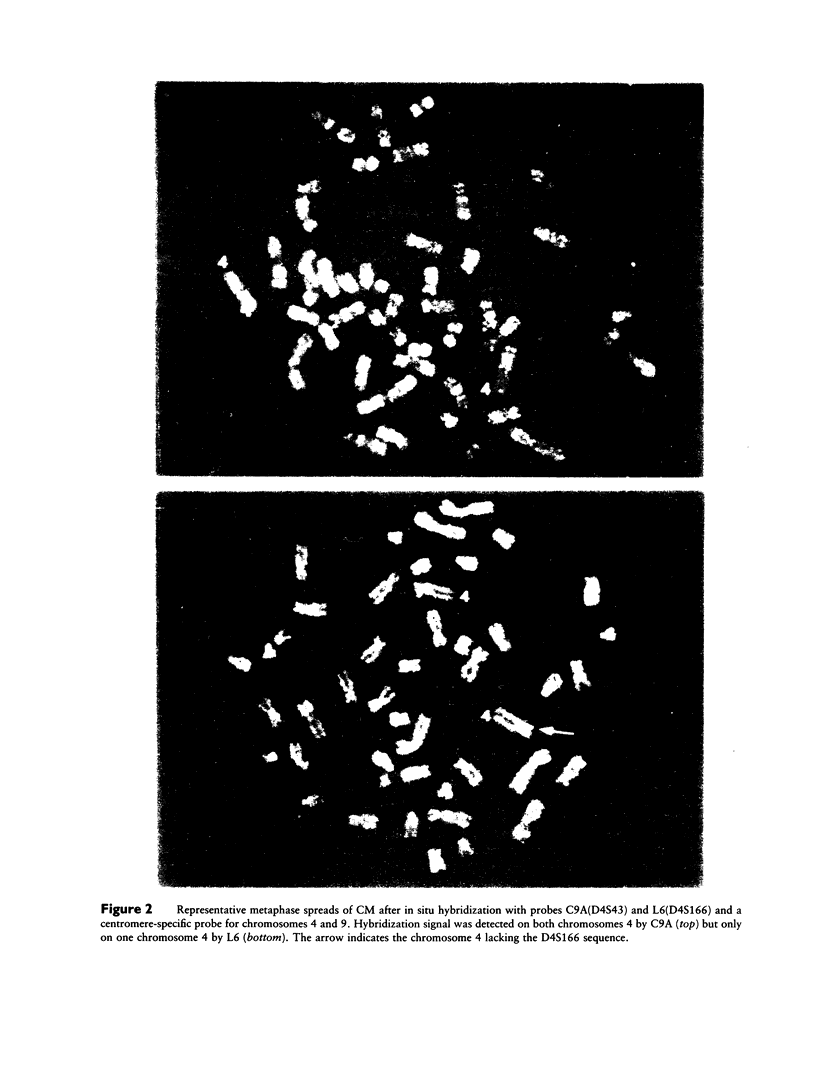
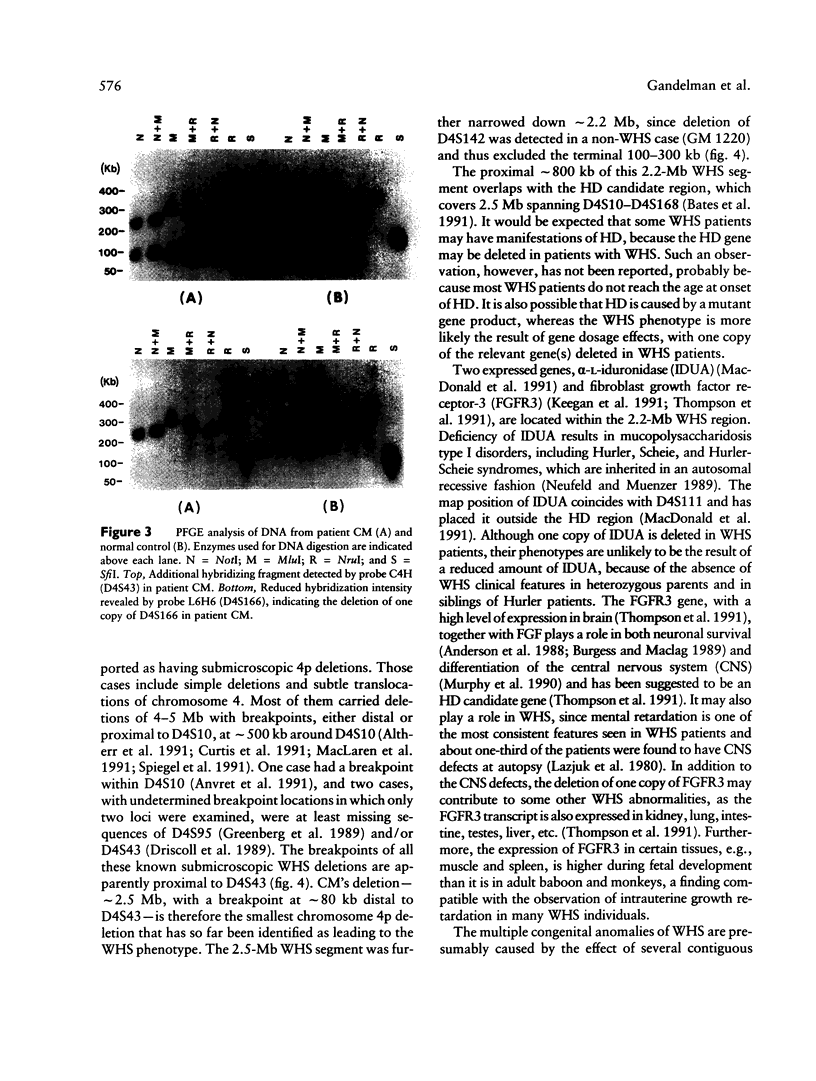
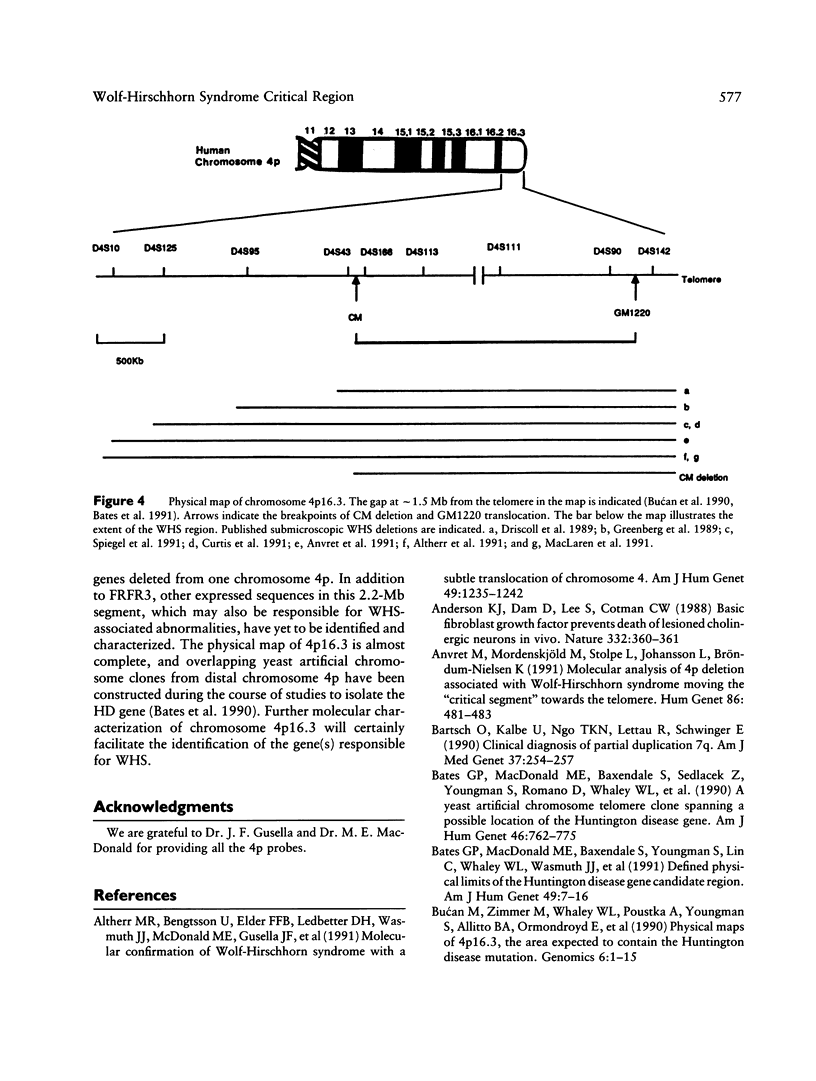
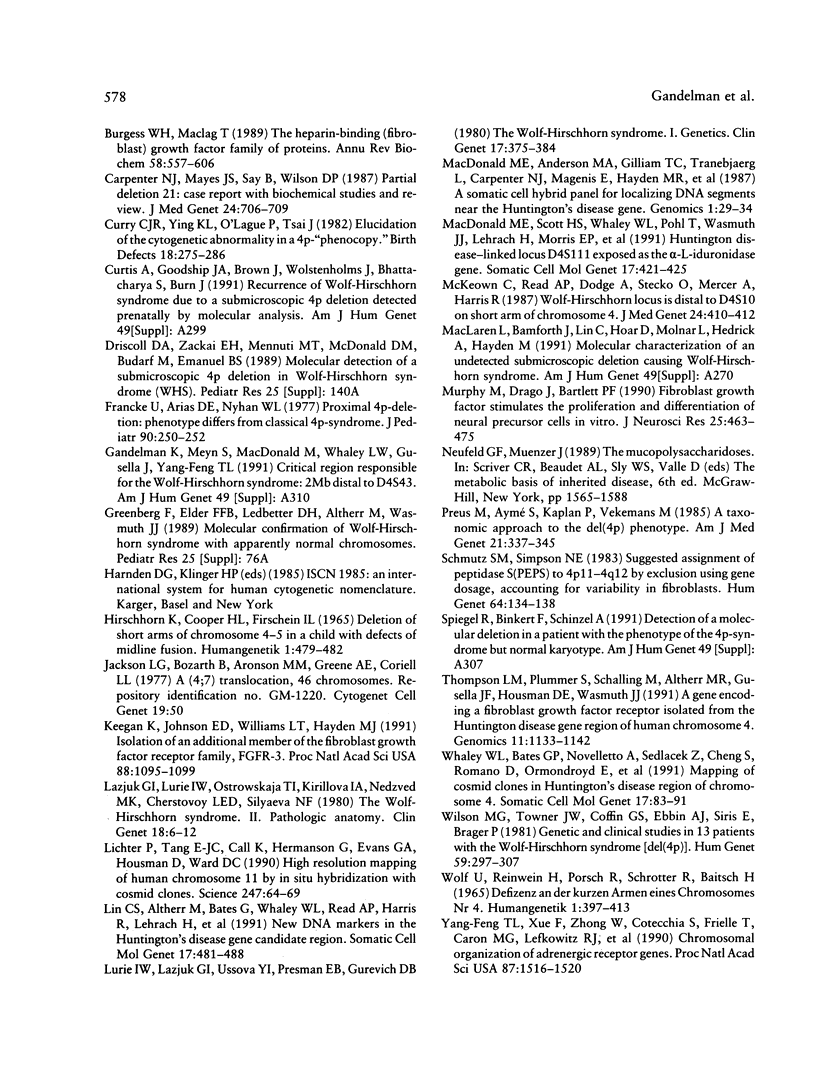
Images in this article
Selected References
These references are in PubMed. This may not be the complete list of references from this article.
- Altherr M. R., Bengtsson U., Elder F. F., Ledbetter D. H., Wasmuth J. J., McDonald M. E., Gusella J. F., Greenberg F. Molecular confirmation of Wolf-Hirschhorn syndrome with a subtle translocation of chromosome 4. Am J Hum Genet. 1991 Dec;49(6):1235–1242. [PMC free article] [PubMed] [Google Scholar]
- Anderson K. J., Dam D., Lee S., Cotman C. W. Basic fibroblast growth factor prevents death of lesioned cholinergic neurons in vivo. Nature. 1988 Mar 24;332(6162):360–361. doi: 10.1038/332360a0. [DOI] [PubMed] [Google Scholar]
- Anvret M., Nordenskjöld M., Stolpe L., Johansson L., Bröndum-Nielsen K. Molecular analysis of 4p deletion associated with Wolf-Hirschhorn syndrome moving the "critical segment" towards the telomere. Hum Genet. 1991 Mar;86(5):481–483. doi: 10.1007/BF00194637. [DOI] [PubMed] [Google Scholar]
- Bartsch O., Kalbe U., Ngo T. K., Lettau R., Schwinger E. Clinical diagnosis of partial duplication 7q. Am J Med Genet. 1990 Oct;37(2):254–257. doi: 10.1002/ajmg.1320370218. [DOI] [PubMed] [Google Scholar]
- Bates G. P., MacDonald M. E., Baxendale S., Sedlacek Z., Youngman S., Romano D., Whaley W. L., Allitto B. A., Poustka A., Gusella J. F. A yeast artificial chromosome telomere clone spanning a possible location of the Huntington disease gene. Am J Hum Genet. 1990 Apr;46(4):762–775. [PMC free article] [PubMed] [Google Scholar]
- Bates G. P., MacDonald M. E., Baxendale S., Youngman S., Lin C., Whaley W. L., Wasmuth J. J., Gusella J. F., Lehrach H. Defined physical limits of the Huntington disease gene candidate region. Am J Hum Genet. 1991 Jul;49(1):7–16. [PMC free article] [PubMed] [Google Scholar]
- Burgess W. H., Maciag T. The heparin-binding (fibroblast) growth factor family of proteins. Annu Rev Biochem. 1989;58:575–606. doi: 10.1146/annurev.bi.58.070189.003043. [DOI] [PubMed] [Google Scholar]
- Bućan M., Zimmer M., Whaley W. L., Poustka A., Youngman S., Allitto B. A., Ormondroyd E., Smith B., Pohl T. M., MacDonald M. Physical maps of 4p16.3, the area expected to contain the Huntington disease mutation. Genomics. 1990 Jan;6(1):1–15. doi: 10.1016/0888-7543(90)90442-w. [DOI] [PubMed] [Google Scholar]
- Carpenter N. J., Mayes J. S., Say B., Wilson D. P. Partial deletion 21: case report with biochemical studies and review. J Med Genet. 1987 Nov;24(11):706–709. doi: 10.1136/jmg.24.11.706. [DOI] [PMC free article] [PubMed] [Google Scholar]
- Curry C. J., Ying K. L., O'Lague P., Tsai J. Elucidation of the cytogenetic abnormality in a 4p- "phenocopy". Birth Defects Orig Artic Ser. 1982;18(3B):275–286. [PubMed] [Google Scholar]
- Francke U., Arias D. E., Nyham W. L. Proximal 4p-deletion: phenotype differs from classical 4p-syndrome. J Pediatr. 1977 Feb;90(2):250–252. doi: 10.1016/s0022-3476(77)80642-2. [DOI] [PubMed] [Google Scholar]
- Hirschhorn K., Cooper H. L., Firschein I. L. Deletion of short arms of chromosome 4-5 in a child with defects of midline fusion. Humangenetik. 1965;1(5):479–482. doi: 10.1007/BF00279124. [DOI] [PubMed] [Google Scholar]
- Jackson L. G., Bozarth B., Aronson M. M., Greene A. E., Coriell L. L. A (4;7) translocation, 46 chromosomes. Repository identification No. GM-1220. Cytogenet Cell Genet. 1977;19(1):50–50. doi: 10.1159/000130795. [DOI] [PubMed] [Google Scholar]
- Keegan K., Johnson D. E., Williams L. T., Hayman M. J. Isolation of an additional member of the fibroblast growth factor receptor family, FGFR-3. Proc Natl Acad Sci U S A. 1991 Feb 15;88(4):1095–1099. doi: 10.1073/pnas.88.4.1095. [DOI] [PMC free article] [PubMed] [Google Scholar]
- Lazjuk G. I., Lurie I. W., Ostrowskaja T. I., Kirillova I. A., Nedzved M. K., Cherstvoy E. D., Silyaeva N. F. The Wolf-Hirschhorn syndrome. II. Pathologic anatomy. Clin Genet. 1980 Jul;18(1):6–12. doi: 10.1111/j.1399-0004.1980.tb01357.x. [DOI] [PubMed] [Google Scholar]
- Lichter P., Tang C. J., Call K., Hermanson G., Evans G. A., Housman D., Ward D. C. High-resolution mapping of human chromosome 11 by in situ hybridization with cosmid clones. Science. 1990 Jan 5;247(4938):64–69. doi: 10.1126/science.2294592. [DOI] [PubMed] [Google Scholar]
- Lin C. S., Altherr M., Bates G., Whaley W. L., Read A. P., Harris R., Lehrach H., Wasmuth J. J., Gusella J. F., MacDonald M. E. New DNA markers in the Huntington's disease gene candidate region. Somat Cell Mol Genet. 1991 Sep;17(5):481–488. doi: 10.1007/BF01233172. [DOI] [PubMed] [Google Scholar]
- Lurie I. W., Lazjuk G. I., Ussova Y. I., Presman E. B., Gurevich D. B. The Wolf-Hirschhorn syndrome. I. Genetics. Clin Genet. 1980 Jun;17(6):375–384. doi: 10.1111/j.1399-0004.1980.tb00167.x. [DOI] [PubMed] [Google Scholar]
- MacDonald M. E., Anderson M. A., Gilliam T. C., Tranejaerg L., Carpenter N. J., Magenis E., Hayden M. R., Healey S. T., Bonner T. I., Gusella J. F. A somatic cell hybrid panel for localizing DNA segments near the Huntington's disease gene. Genomics. 1987 Sep;1(1):29–34. doi: 10.1016/0888-7543(87)90101-7. [DOI] [PubMed] [Google Scholar]
- MacDonald M. E., Scott H. S., Whaley W. L., Pohl T., Wasmuth J. J., Lehrach H., Morris C. P., Frischauf A. M., Hopwood J. J., Gusella J. F. Huntington disease-linked locus D4S111 exposed as the alpha-L-iduronidase gene. Somat Cell Mol Genet. 1991 Jul;17(4):421–425. doi: 10.1007/BF01233067. [DOI] [PubMed] [Google Scholar]
- McKeown C., Read A. P., Dodge A., Stecko O., Mercer A., Harris R. Wolf-Hirschhorn locus is distal to D4S10 on short arm of chromosome 4. J Med Genet. 1987 Jul;24(7):410–412. doi: 10.1136/jmg.24.7.410. [DOI] [PMC free article] [PubMed] [Google Scholar]
- Murphy M., Drago J., Bartlett P. F. Fibroblast growth factor stimulates the proliferation and differentiation of neural precursor cells in vitro. J Neurosci Res. 1990 Apr;25(4):463–475. doi: 10.1002/jnr.490250404. [DOI] [PubMed] [Google Scholar]
- Preus M., Aymé S., Kaplan P., Vekemans M. A taxonomic approach to the del(4p) phenotype. Am J Med Genet. 1985 Jun;21(2):337–345. doi: 10.1002/ajmg.1320210216. [DOI] [PubMed] [Google Scholar]
- Schmutz S. M., Simpson N. E. Suggested assignment of peptidase S (PEPS) to 4p11-4q12 by exclusion using gene dosage, accounting for variability in fibroblasts. Hum Genet. 1983;64(2):134–138. doi: 10.1007/BF00327109. [DOI] [PubMed] [Google Scholar]
- Thompson L. M., Plummer S., Schalling M., Altherr M. R., Gusella J. F., Housman D. E., Wasmuth J. J. A gene encoding a fibroblast growth factor receptor isolated from the Huntington disease gene region of human chromosome 4. Genomics. 1991 Dec;11(4):1133–1142. doi: 10.1016/0888-7543(91)90041-c. [DOI] [PubMed] [Google Scholar]
- Whaley W. L., Bates G. P., Novelletto A., Sedlacek Z., Cheng S., Romano D., Ormondroyd E., Allitto B., Lin C., Youngman S. Mapping of cosmid clones in Huntington's disease region of chromosome 4. Somat Cell Mol Genet. 1991 Jan;17(1):83–91. doi: 10.1007/BF01233207. [DOI] [PubMed] [Google Scholar]
- Wilson M. G., Towner J. W., Coffin G. S., Ebbin A. J., Siris E., Brager P. Genetic and clinical studies in 13 patients with the Wolf-Hirschhorn syndrome [del(4p)]. Hum Genet. 1981;59(4):297–307. doi: 10.1007/BF00295461. [DOI] [PubMed] [Google Scholar]
- Wolf U., Reinwein H., Porsch R., Schröter R., Baitsch H. Defizienz an den kuzen Armen eins Chromosoms Nr. 4. Humangenetik. 1965;1(5):397–413. [PubMed] [Google Scholar]
- Yang-Feng T. L., Xue F. Y., Zhong W. W., Cotecchia S., Frielle T., Caron M. G., Lefkowitz R. J., Francke U. Chromosomal organization of adrenergic receptor genes. Proc Natl Acad Sci U S A. 1990 Feb;87(4):1516–1520. doi: 10.1073/pnas.87.4.1516. [DOI] [PMC free article] [PubMed] [Google Scholar]



